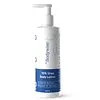What's inside
What's inside
 Key Ingredients
Key Ingredients

 Benefits
Benefits

 Concerns
Concerns

 Ingredients Side-by-side
Ingredients Side-by-side

Water
Skin ConditioningUrea
BufferingGlycerin
HumectantButyrospermum Parkii Butter
Skin ConditioningCeteareth-20
CleansingCetearyl Alcohol
EmollientGarcinia Indica Seed Butter
Skin ConditioningMangifera Indica Seed Butter
Skin ConditioningButylene Glycol
HumectantCetyl Alcohol
EmollientCyclopentasiloxane
EmollientDimethicone
EmollientPhenoxyethanol
PreservativeEthylhexylglycerin
Skin ConditioningParfum
MaskingTocopheryl Acetate
AntioxidantStearic Acid
CleansingZinc Oxide
Cosmetic ColorantBHT
AntioxidantDisodium EDTA
Imidazolidinyl Urea
PreservativePolyacrylate-13
Polyisobutene
Polysorbate 20
EmulsifyingCeramide NP
Skin ConditioningCeramide AP
Skin ConditioningCeramide EOP
Skin ConditioningPhytosphingosine
Skin ConditioningCholesterol
EmollientSodium Lauroyl Lactylate
EmulsifyingCarbomer
Emulsion StabilisingXanthan Gum
EmulsifyingWater, Urea, Glycerin, Butyrospermum Parkii Butter, Ceteareth-20, Cetearyl Alcohol, Garcinia Indica Seed Butter, Mangifera Indica Seed Butter, Butylene Glycol, Cetyl Alcohol, Cyclopentasiloxane, Dimethicone, Phenoxyethanol, Ethylhexylglycerin, Parfum, Tocopheryl Acetate, Stearic Acid, Zinc Oxide, BHT, Disodium EDTA, Imidazolidinyl Urea, Polyacrylate-13, Polyisobutene, Polysorbate 20, Ceramide NP, Ceramide AP, Ceramide EOP, Phytosphingosine, Cholesterol, Sodium Lauroyl Lactylate, Carbomer, Xanthan Gum
Water
Skin ConditioningUrea
BufferingIsopropyl Palmitate
EmollientCetyl Acetate
EmollientPEG-100 Stearate
Glyceryl Stearate
EmollientCetearyl Alcohol
EmollientPetrolatum
EmollientPalmitic Acid
EmollientStearic Acid
CleansingStearyl Acetate
EmollientMethylparaben
PreservativePolysorbate 60
EmulsifyingOleyl Acetate
EmollientPropylparaben
PreservativeCarbomer
Emulsion StabilisingMyristic Acid
CleansingAcetylated Lanolin Alcohol
EmollientArachidic Acid
CleansingEthyl Acetate
PerfumingCyclohexane
SolventWater, Urea, Isopropyl Palmitate, Cetyl Acetate, PEG-100 Stearate, Glyceryl Stearate, Cetearyl Alcohol, Petrolatum, Palmitic Acid, Stearic Acid, Stearyl Acetate, Methylparaben, Polysorbate 60, Oleyl Acetate, Propylparaben, Carbomer, Myristic Acid, Acetylated Lanolin Alcohol, Arachidic Acid, Ethyl Acetate, Cyclohexane
Ingredients Explained
These ingredients are found in both products.
Ingredients higher up in an ingredient list are typically present in a larger amount.
Carbomer is a polymer of acrylic acid. Its main role is to create a gel consistency.
A high amount of carbomer can cause pilling or balling up of products. Don't worry, most products contain 1% or less of carbomer.
Cetearyl alcohol is a mixture of two fatty alcohols: cetyl alcohol and stearyl alcohol. It is mainly used as an emulsifier. Emulsifiers help prevent the separation of oils and products. Due to its composition, it can also be used to thicken a product or help create foam.
Cetearyl alcohol is an emollient. Emollients help soothe and hydrate the skin by trapping moisture.
Studies show Cetearyl alcohol is non-toxic and non-irritating. The FDA allows products labeled "alcohol-free" to have fatty alcohols.
This ingredient is usually derived from plant oils such as palm, vegetable, or coconut oils. There is debate on whether this ingredient will cause acne.
Due to the fatty acid base, this ingredient may not be Malassezia folliculitis safe.
Learn more about Cetearyl AlcoholStearic Acid is a fatty acid. It is an emollient, emulsifier, and texture enhancer.
As an emollient, stearic acid helps soften skin. It aids the skin's protective barrier by preventing water loss. It also provides a gentle cleansing effect without stripping away natural oils.
Stearic acid may also be used to enhance the texture of products. It can add volume and stabilize ingredients such as water and oil. This can help water and oil ingredients from separating.
Sources of stearic acid include animal or vegetable fats/oils such as coconut or shea. It can be naturally found in butter, cocoa butter, shea butter, vegetable fats, and animal tallow.
This ingredient may not be Malassezia folliculitis, or fungal-acne safe.
Learn more about Stearic AcidUrea is also called carbamide and is the diamide of carbonic acid. In cosmetics, urea is used to hydrate the skin. It also provides exfoliation in higher concentrations.
As a humectant, urea helps draw moisture from the air and from deep within the skin. This helps hydrate your skin. Studies show urea is an effective moisturizer for dry skin conditions. 40% urea is typical in medications for treating eczema and other skin conditions.
Urea has the strongest exfoliation effect in concentrations higher than 10%. It is a keratolytic agent, meaning it breaks down the keratin protein in the top layer of skin. This helps remove dead skin cells and flaking skin.
In medicine, urea has been shown to help increase the potency of other ingredients, such as fungal treatments.
Humans and animals use urea to metabolize nitrogen-containing compounds. Urea is highly soluble in water. Once dissolved, it is neither acidic nor alkaline.
Learn more about UreaWater. It's the most common cosmetic ingredient of all. You'll usually see it at the top of ingredient lists, meaning that it makes up the largest part of the product.
So why is it so popular? Water most often acts as a solvent - this means that it helps dissolve other ingredients into the formulation.
You'll also recognize water as that liquid we all need to stay alive. If you see this, drink a glass of water. Stay hydrated!
Learn more about Water